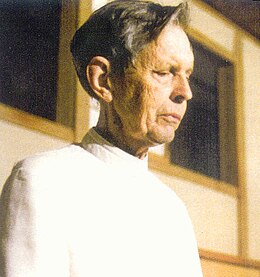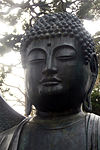 Wiki90
Wiki90
Wiki90: 90s Style Encyclopedia on the Web

|

|

|

|




Hugo Enomiya-Lassalle
In this article we will analyze the relevance of Hugo Enomiya-Lassalle in the current context, exploring its implications in various areas. Hugo Enomiya-Lassalle has been an object of interest and study for a long time, and its influence continues to be a cause for debate and reflection. Throughout history, Hugo Enomiya-Lassalle has played a fundamental role in different areas, from politics to culture, technology and society in general. In this sense, it is crucial to understand the importance of Hugo Enomiya-Lassalle in today's world, as well as its potential to shape the future. Through an in-depth and multidisciplinary analysis, this article aims to shed light on the relevance of Hugo Enomiya-Lassalle today, offering a critical and reflective look at its impact and possible long-term implications.
This article needs additional citations for verification. (May 2014) |

| Part of a series on |
| Zen Buddhism |
|---|
 |
| Part of a series on |
| Western Buddhism |
|---|
 |
Hugo Makibi Enomiya-Lassalle (11 November 1898 in Gut Externbrock near Nieheim, Westphalia – 7 July 1990 in Münster, Westphalia) was a German Jesuit priest and one of the foremost teachers to embrace both Roman Catholic Christianity and Zen Buddhism.
Biography
Hugo Lassalle passed his school days from 1911 to 1916 at the Gymnasium Petrinum in Brilon in 1917. Because of an injury in the First World War, Hugo Lassalle was admitted to the military hospital of Brilon in 1917. Enomiya-Lassalle joined the Society of Jesus on 25 April 1919. At the end of the usual Jesuit spiritual and academic training he was ordained priest on 28 August 1927.
He travelled to Japan as a missionary in 1929 and became interested in that country's Buddhist practices. In 1940, he became the vicar of Hiroshima, and on 6 August 1945 he was critically wounded by the nuclear blast in that city, which is depicted in John Hersey's book Hiroshima. Shortly thereafter, he returned to Germany.
In September 1946, he had an audience with Pope Pius XII, in which he revealed his plan to build in Hiroshima a cathedral dedicated to the idea of world peace. Designed by Japanese architect Togo Murano, construction on the cathedral began in 1950 and on 6 August 1954, the Memorial Cathedral for World Peace (ja) was dedicated.
In 1956, Enomiya-Lassalle began studying Zen with Harada Daiun Sogaku. In 1958, he published Zen: A Way to Enlightenment.
Following Harada's death in 1961, Enomiya-Lassalle became an apprentice of one of Harada's students, Yamada Kōun. Yamada was enthusiastic about the possibilities of Zen as a Christian practice, believing that "Zen would become an important stream in the Catholic Church one day". With Enomiya-Lassalle's active assistance, he attracted a number of Catholic priests and nuns as students. In the late 1960s, Enomiya-Lasalle was certified as a teacher in Yamada's Sanbo Kyodan sect and given the title roshi (Zen master), while professing his continued belief in Christianity. After 1968, Enomiya-Lassalle spent much of his time in Europe leading Zen retreats and encouraging Zen practice among Christians. His books influenced symphony conductor Herbert von Karajan to study Zen and incorporate a Zen mindset into his conducting.

Bibliography
- Zen: Way to Enlightenment (1964)
- Zen Meditation for Christians (1974)
- Living the New Consciousness (1984)
- The Practice of Zen Meditation, (1987, Thorsons).
See also
References
- ^ a b c d Akinade, Akintunde E. (2010). A New Day: Essays on World Christianity in Honor of Lamin Sanneh. Peter Lang. p. 242. ISBN 9781433104565.
- ^ John Hersey: Hiroshima; Vintage Books, New York 1989, p 11 etc
- ^ "【平和の使徒】 世界平和記念聖堂 (Memorial Cathedral for World Peace) – カトリック広島司教区平和の使徒推進本部".
- ^ a b Oldmeadow, Harry (2004). Journeys East: 20th Century Western Encounters with Eastern Religious Traditions. World Wisdom, Inc. pp. 429–430. ISBN 9780941532570.
- ^ Terebess Asia Online
 Hugo Makibi Enomiya-Lassalle
Hugo Makibi Enomiya-Lassalle Hugo Enomiya-Lassalle
Hugo Enomiya-Lassalle Hugo Enomiya-Lassalle
Hugo Enomiya-Lassalle Hugo Makibi Enomiya-Lassalle
Hugo Makibi Enomiya-Lassalle Hugo M. Enomiya Lassalle
Hugo M. Enomiya Lassalle Hugo Enomiya-Lassalle
Hugo Enomiya-Lassalle Hugo Enomiya-Lassalle
Hugo Enomiya-Lassalle Hugo Enomiya-Lassalle
Hugo Enomiya-Lassalle Hugo Enomiya-Lassalle
Hugo Enomiya-Lassalle

